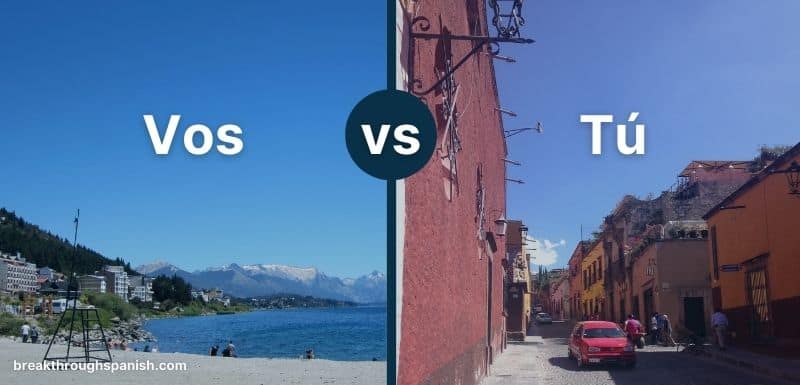As speakers of modern English, we’re blessed with a simple one-word solution to addressing someone:
You.
But languages aren’t like that — including Spanish.
In Spanish, we have multiple ways to address a person. This changes based on situation, geography, and the respect or formality you want to show.
Vos is one such pronoun in Spanish. Most Spanish classes don’t cover it, but it’s very common across Latin America.
Let’s take a closer look at the origin, meaning, and usage of vos in Spanish
What does Vos mean?
Vos is a generally informal way to say ‘you’. It’s used — at least to some extent — in parts of almost every Latin American country. To describe vos as a general concept, we use the term voseo.
Where is vos used?
Vos is the standard form of address (instead of tú) in Argentina, Uruguay, and Paraguay. It’s also common (mixed with tú, often depending on region, situation and social class) in Costa Rica, Nicaragua, Honduras, El Salvador, and Guatemala.
You’ll also hear it in southern Mexico and parts of Bolivia, Peru, Ecuador, Colombia, Venezuela, Panama, and Cuba. Again, its usage in these countries varies based on factors like social class.
In Chile, voseo exists in a unique form. Chilean Spanish frequently combines the pronoun tú with a slightly different verb conjugation. The pronoun vos itself (shortened to vo’ in Chile) is reserved for very informal situations among (typically young) friends, or as a form of disrespect.
Origin of Vos in Spanish
Vos comes originally from Latin. Latin speakers used vos in the 2nd person plural (what would in modern Spanish be ustedes or vosotros).
Around 200 B.C., the Romans defeated the Carthaginians, letting the Romans control the Iberian Peninsula (Modern Spain). With this, Latin took root in the region and evolved into Spanish over the next 1500 years.
Language change happens slowly. But one significant change was how vos was used.
Here’s how it started, around 300 A.D.:
With only two contrasts (singular vs. plural, first person vs. second person) the paradigm remained stable with only four elements; however, in A.D. 300 the paradigm acquired a new contrast that caused the distinctions to blur. This new contrast appeared when Roman royalty began using the second person plural form, vos, when referring to the emperor, a single individual… As more royalty used vos when referring to a single person, vos began to lose its central meaning of “plural” and to gain a marginal meaning of ‘respect’.”
-A Diachronic History of Spanish Second Person Pronoun Vos, George Myers, 1997
Over the centuries, more and more people began to use vos to refer to people of equal or superior social status, and tú was reserved for the lower classes.
Since vos was no longer plural, this left a gap. Speakers began to say vos + otros to address groups of people. This soon became vosotros.
But before vosotros could become entrenched in all of Spain, the country began sending its conquistadores to the New World. Because of this, vosotros never traveled to the Americas, which explains its lack of use there.
Back in 16th century Spain, speakers of all classes were using vos. This meant that upper class speakers began to avoid it out of prejudice — it began to seem vulgar to them.
Eventually, vos fell completely out of favor. In fact, by the 17th century in Spain, addressing someone with vos was considered an insult.
This left only tú, so speakers needed a new way to communicate respect. They began to use vuestra merced (your grace), which became the modern usted.
Note: in the Americas, vos only fell out of favor in colonies with closer ties to Spain (like Mexico and Peru). In more distant colonies, like Argentina, vos never lost currency and thrives to this day.
How to conjugate and use Vos in Spanish
To use vos, you need to know a few things:
- When to use vos instead of tú/tí
- How to conjugate it
When to use vos instead of tú or tí
In prepositional phrases, replace tú with vos:
Con vos – voy con vos y María
A vos – ¿A vos te importa?
Para vos – Es un regalo para vos
Otherwise, you use the various tu forms.
No veo tu auto, el auto es tuyo, te pago mañana.
How to conjugate vos
Vos conjugations are simpler than tú forms, because they lack the “stem-changing” aspect (e.g., vos podés from poder instead of tú puedes).
In voseo, the emphasis always goes on the last syllable of the verb, which is denoted by an accent: vos llamás/tomás/comés,escribís, etc.
Voseo: Present Indicative & Present Imperative Tense
If it’s an -ar verb, it ends in -ás.
| Present | Imperative |
| Vos hablás, pagás, cocinás | Hablá, pagá, cociná |
| Ex: ¿Vos hablás español? (Do you speak Spanish?) | Ex: Hablá con tu mamá (Speak with your mom) |
If it’s an -er verb, it ends in -és.
| Present | Imperative |
| Vos bebés, corrés, vendés | bebé, corré, vendé |
| Ex: ¿Vos corrés mucho? (Do you run a lot? | Ex: ¡Corré rápido! (Run fast!) |
If it’s an -ir verb, it ends in -ís.
| Present | Imperative |
| Vos venís, salís, decís | vení, salí, decí |
| Ex: Vos venís conmigo (You’re coming with me) | Ex: ¡Vení conmigo! (Come with me!) |
Three exceptions:
- Ir: tú vas (you’re going) doesn’t change in the voseo. We just say ‘vos vas’.
- Haber: tú has (you have [done xyz] doesn’t change. We just say ‘vos has…‘
- Ser: Tú eres changes to vos sos
Other verb forms
In the standard voseo, conjugations don’t change except for in the present (indicative and imperative) tenses. You don’t need to worry about it in the preterite, imperfect, etc. In some places, the subjunctive uses voseo, but this isn’t standard.
Do I need to learn the voseo?
I recommend at least getting familiar with it so you understand when others use it with you (same goes for Spain’s vosotros).
If you are planning to spend lots of time in one of the vos-dominant countries listed above, you should practice using it yourself.
Like anything in Spanish, it’s a simple practice of (1) getting familiar and (2) practicing.
Have you used the voseo before? How comfortable are you with it? Do you understand when people use vos with you? Let me know in the comments.


